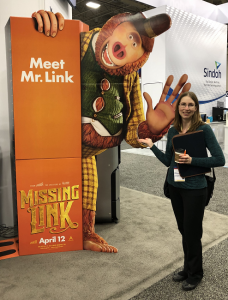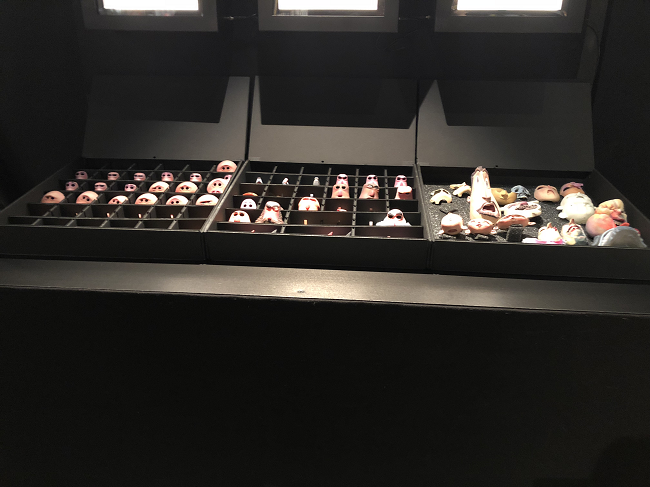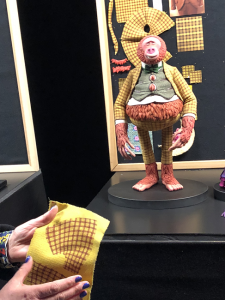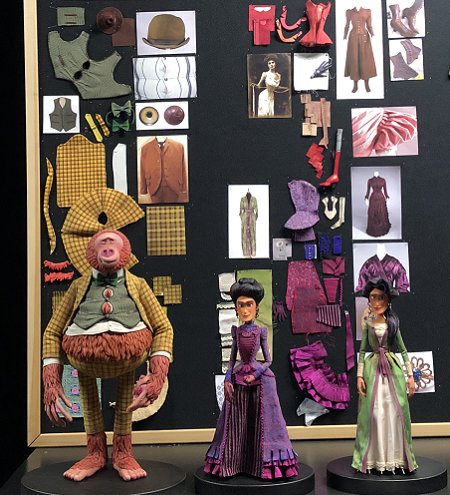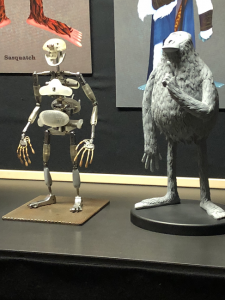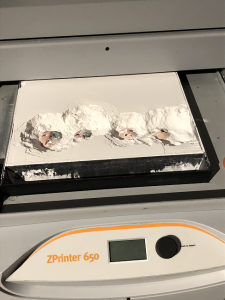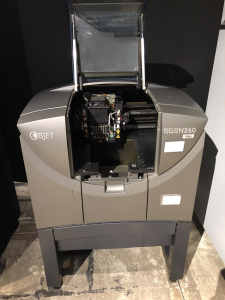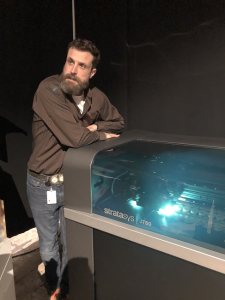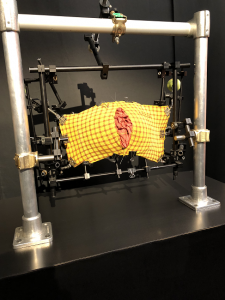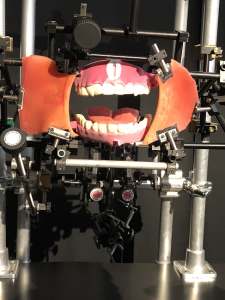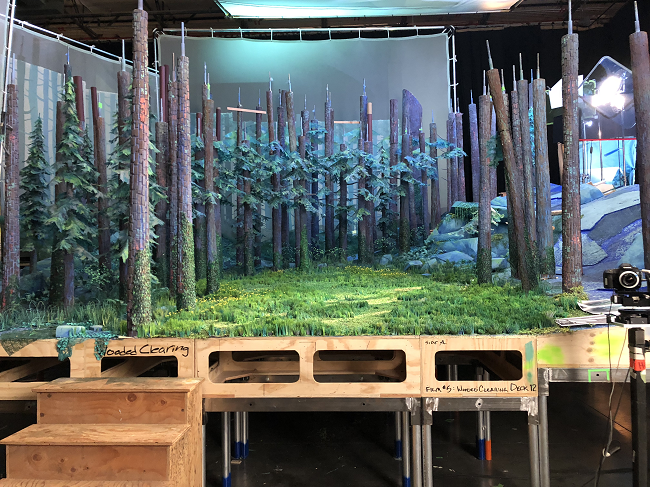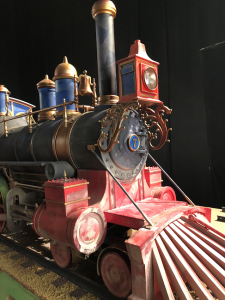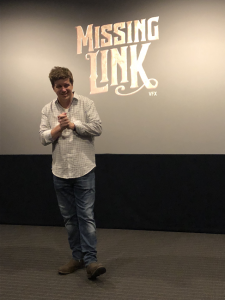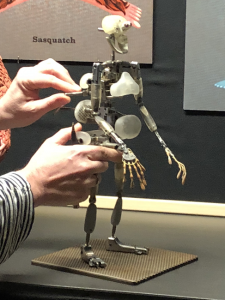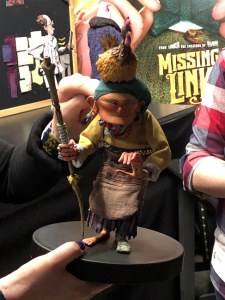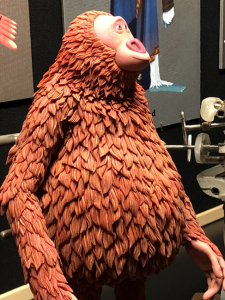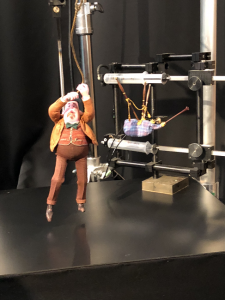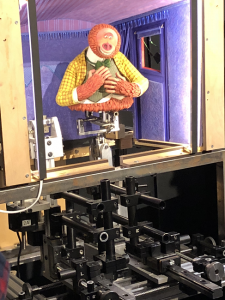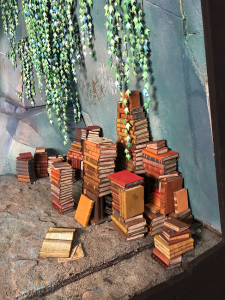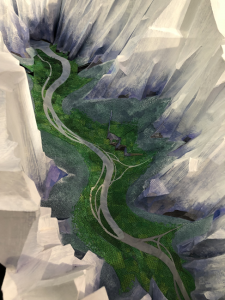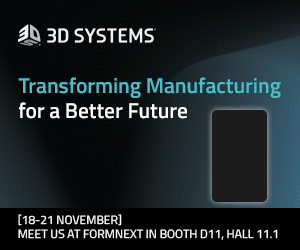3DPrint.com’s Visit to LAIKA Studios: Stratasys J750 3D Printer Put to Work for New Stop Motion Animation Film
Not too long ago, I made the trip down to Dallas, Texas to attend SOLIDWORKS World 2019. I had the opportunity to speak with several 3D printing companies while I was there, including Stratasys. Prominently displayed in the booth was the company’s multi-color, multi-material J750 3D printer, which was first introduced two years ago. It offers more than 500,000 different color combinations, so parts and components can be produced in multiple colors and textures for a wide variety of different applications. The printer can also make gradient parts with different flexibility and hardness across the part.
“The J750 is the most realistic printer on the market,” Gina Scala, the Director of Education at Stratasys, told me during the event. “Realism, as you think about that, means something different to a car manufacturer than it does to a surgeon planning their approach, right?
“We have created a tool that allows for that hyper realism to be in the hands of the designers, and allows them to push the limits, to have their prototypes look as close to the real thing as possible.”
Then she brought up Oregon-based film studio LAIKA, which has used 3D printing in the creation of characters for several of its stunning stop motion animation movies, such as The Box Trolls, Coraline, ParaNorman, and Kubo and the Two Strings, which was the first film ever nominated at the Academy Awards in both the Animated Feature and Visual Effects categories.
Scala said, “‘Missing Link’ is coming out on April 12th – it’s their new feature length film, and it’s all leveraging the J750 technology.”
Craig Librett, the Senior Public Relations & Public Affairs Manager at Stratasys, chimed in here:
“This is the first time that LAIKA has used entirely the J750 for the entire film. They used to use a combination of different printers and different technologies, but they’re calling the J750 the ‘nirvana’ of what they want in 3D printing.
“It’s a real demonstration of the J750. It’s really a unique case, you know, and it just shows what in other industries can be done with the J750.”
LAIKA is no stranger to Stratasys technology, having worked with its J750 3D printer since 2015.
“They’re able to control what they want material-wise at the voxel level, at the resolution and the quality that they’re looking for, they’re able to control and input that data into the printer and get out that exact match, that realistic character,” Scala explained.
She explained how LAIKA makes faces for their stop motion characters that can snap on and off, which is an easy solution for switching up the many different facial expressions that make a character, but difficult when it comes to matching colors and small details. The studio also needs to worry about proper lighting, in terms of how bright movie lights will reflect off of a character like the orange Mr. Link of its new movie.
“These are the things that they’re thinking of, right?” Scala said. “It’s not just, hey, here’s a really cool printer, and we have some really cool ideas, let’s print – they’re thinking through all of that, how light hits and is absorbed, and so on. So they’re really excited about this movie, and we’re really excited about this movie.”
Missing Link stars Zoe Saldana, Hugh Jackman, Emma Thompson, and Zach Galifianakis, among others, and is about Sir Lionel Frost (Jackman), an investigator of myths and monsters. However, none of his high-society adventuring cohorts believe the wonders he’s seen, which is why he makes a last-ditch effort to prove that the legendary Sasquatch – a “living remnant of Man’s primitive ancestry,” as IMDB says – actually exists while on a trip to America’s Pacific Northwest. He then teams up with said Bigfoot, also known as Mr. Link and Susan (you’ll find out why!), and his old flame Adelina Fortnight, on a globe-trotting adventure to help Mr. Link find his long-lost cousins.
It just so happens that I was in the Pacific Northwest last week – in Portland, Oregon, to be more precise. I flew across the country, at the invitation of Stratasys and LAIKA, to join a group of other journalists on an exciting behind-the-scenes tour of the studio ahead of its upcoming movie release. The tour went deep into the film-making process and, as Librett told me ahead of time, explored “how LAIKA is exclusively using 3D printing to accelerate this animation journey.”
Once we all got checked in, we were taken to a small screening room to meet with Missing Link producer Arianne Sutner and Chris Butler, who wrote and directed the film. Butler was also the writer and co-director of the studio’s 2012 film ParaNorman.
“I always want to do different things,” Butler told us in regards to the film being a lot lighter than the last few movies the studio has completed. “I had a selection of projects that I proposed…for my next project, and this was the one that we kind of gravitated towards, and I think that was one of the reasons – that it was this bold, colorful movie that was not like the other stuff we’d done previously.
“There were quite a few elements to this that I think were appealing…that were different, and one of them being the main characters in this are adults, which is not something we’ve done for a long time. There are a lot of little things like that that made it seem like it was something fresh, and that’s what we want to do.”
Missing Link, which took about five years to make, is LAIKA’s “most ambitious film to date,” and was described as a combination of Indiana Jones, Sherlock Holmes, and Around the World in 80 Days, with monsters…definitely sounds like my kind of story. This was the first movie the studio completed where the “facial animation was bespoke,” as the Stratasys J750 helped LAIKA achieve an “amazing level of nuance” for the over 106,000 3D printed faces.
We were then treated to about 26 minutes of footage that the public has not seen yet, along with an extended trailer, before moving on to speak with costume designer Deborah Cook. She talked to us about working with a skilled local weaver to find out what shapes, colors, and threads could be used to trick the camera, and how both the costume and scenery teams were inspired by things like tin ceiling tiles and quilting.
The 25-person costume team was able to “adopt different techniques” in rapid prototyping, such as laser cutting and embossing, to make the costumes. The characters have to bend, so their costumes must be flexible enough to allow this movement, but also be strong enough to remain consistent.
“The more self-sufficient we become, the more we can easily scale up or down,” Cook said.
Cook showed us a fur cloak and then opened it up so we could see all of the mesh, foam rubber, and gauge wires inside.
“Underneath is a lot of engineering,” she explained. “So all of the costumes have something like this within them…so that we can capture them for every 24 of those frames a second. We can move this jacket to be still, and then move it back again, so each incremental moment will build up that fluidity of movement.”
Next up was puppets with creative lead John Craney, who told us that the 86 people on the team were from a variety of different backgrounds, such as jewelers, illustrators, and “art school rejects.” Nine months of development go into making a stage-ready stop motion animation puppet, and Craney said that it was “a very exciting proposition” to create the robust, furry character of Mr. Link.
Once the puppet team goes through all of the scripts and story boards to get a feel for the film, they then get to see the 2D images of the characters created by Butler and his design team. A veteran concept sculptor, who’s worked on every LAIKA film since Coraline, interprets these 2D turnarounds in order to “reinforce and communicate the character” and its personality. Once the sculpture is approved by the director, the puppet creative team gets to work.
“This helps us with scale…but we also look to anything that might be problematic,” Craney said about the sculpt of Mr. Link. “We look to anything that might compromise the performance of this character.”
The armature, or Terminator as I wrote in my notes, of the puppet consists of over 250 components made out of unbreakable climbing resin, while the puppets themselves are silicone. Craney noted that since Mr. Link is somewhat human, the team can break down the puppet and its movements in the same way, including the use of ball and socket joints and a swiveling forearm.
“He’s really something,” Craney said about the Mr. Link puppet.
After the puppet demonstration, Brian McLean, LAIKA’s Director of Rapid Prototyping, spoke to our small group about the studio’s use of 3D printing to make the faces for the stop motion animation characters. While I’ll go into more detail on this discussion later, I will note that the studio has been using 3D printing for quite some time, including a color ZPrinter 650 for ParaNorman and the compact Objet Eden260 for the faces in Coraline.
LAIKA entered the world of resin color 3D printing with the Connex3, though it wasn’t in the room at the moment, and was actually a beta user for the J750, before immediately purchasing “the first five off the assembly line” once the multi-material system was officially released.
“They’re kind of like really fancy Mr. Potato Heads in a way,” McLean said about the puppets with their 3D printed faces. “During shooting, if an ear gets cracked or if an ear breaks, we can go in there and surgically, while we’re on set, it’s like the game Operation, we’ll go in there surgically and unscrew the ear and put another one on.”
- Brian McLean
Ollie Jones, the Head of Rigging, explained to us how everything in a stop motion animation film that moves requires a rig.
“Because of the stop motion process, a puppet cannot leave the ground without some kind of assist,” Jones said. “Mr. Link was a good example of being a top-heavy puppet…weighed nearly six pounds. So when he’s walking on his toes, he always needs an assist.”
XYZ rigs, which Jones said are something like “a mechanical Etch A Sketch,” help the animators position the puppets “grossly in space” in more subtle increments. Rig plugs give the team more freedom in connecting to the puppet without having to physically turn screws inside it. Autodesk Inventor is used to design a lot of the rigging equipment, which is then built in house.
“What’s really great about working at LAIKA is you really get to indulge in the details,” Jones said when showing us the rigging for a moving carriage. “We set up our own unit where we could have some live action tassels. We created an XYZ rig and we bounced the tassels around, and we really studied how they moved and tried to work on how we could reduce that movement to just two simple axes.”
Something interesting I learned from Jones is that when it comes to rigging in stop motion animation, you’re not leaning in to motion so much as you’re actually trying to stop it, so animators can have more control of the characters…or their various body parts. We got to see a 300% scaled up version of Mr. Link’s furry rear end, along with a 600% scaled up version of his mouth, which, coincidentally, features 3D printed teeth and cheeks that were cast from a 3D printed design.
“I think it’s the most axes we’ve ever put on a tongue before,” Jones said, while using the rigging to manipulate the mouth as we all laughed.
Then we took a brief lunch break before heading out with production designer Nelson Lowry on an art and stage tour, which was just fascinating. Lowry is responsible for “the look and feel of the film,” along with the director. To create the film’s multiple turn of the century locations, a lot of time was spent on reference searches, both online and in books at the Library of Congress, and even postcards.
“Chris Butler had a couple of tent-pole descriptions of how he wanted the film to feel,” Lowry said about the director. “He wanted it to be colorful and epic.
“The other thing he liked was Victorian patterning, and very specifically tile work, brickwork, slate roofs, some of the fabrics, wallpaper…all the surfaces have some kind of patterning in them,” he continued. “The other thing that I thought was a strong starting point for the design was Chris’s characters…they’re very stylized.
“That really sets the ground rules for all the design of the film. The environments have to give them a home, basically.”
And what a home they provided! This film takes place all around the world – 60 unique locations, in fact – including London, a forest in the Pacific Northwest, a ship on the ocean, a logging town in Santa Ana, a train, snowy mountains, and the Yeti temple in the valley of Shangri-La. Each set has three main colors, with the exception of the moving train, and while cross-training is currently taking place, Lowry told us that only about 5% of the set pieces were 3D printed; the rest are handmade.
“Someone still has to design it on a computer; it doesn’t really save that much,” he explained.
Our LAIKA host for the day, Dan Pascall, explained that the goal during each week of filming was to create a total of 4.3 seconds of footage by shooting a frame, then shooting it again so the film can be shown in 3D, manipulating the puppets ever so slightly for the next shot, and then doing it all over again. That’s why the sets need to be extremely accessible, so the team can easily get in and out to move the puppets and other scenery around as needed.
While I could have spent hours photographing the various set pieces at LAIKA, we had one more interesting stop before heading out for the day.
We returned to the screening room to meet with with visual effects supervisor Steve Emerson for a brief VFX presentation. Emerson has been with LAIKA for 11 years and has contributed to all five of its stop motion animation films.
Obviously, it takes a long time to make one of these movies, especially with the level of detail that LAIKA adds, which is why Emerson said that there’s always an “intense amount of collaboration on set.”
“Our idea was we were going to tell the stories we wanted to tell, without limitations, and we were going to leverage technology in order to do that,” Emerson said. “When we brought technology into the mix, we wanted to do so in a way that would ultimately respect and honor the art of stop motion animation.”
The Missing Link film had a “huge scope,” with lots of props and puppets, and Emerson explained that “VFX helps tell the stories” of the films right along with the other teams. The department mostly uses MAYA software, along with FURNACE, KATANA, MARI, NUKE, OCULA, and Silhouette SFX. There were a total of 1,486 shots in Missing Link, which Emerson referred to as “1,486 little stories,” and 112 million processor hours were logged, through 400 hosts on a 10G network, to create them.
One of the main things VFX is used for in LAIKA’s stop motion animation films is to create set extensions; Missing Link featured 465 of these. 460 shots in the film used digital effects work to create things like snow spray, smoke, and clouds, and the department also cleaned over 1,000 rigs out of the film. In addition, VFX takes care of cosmetics, such as cleaning up “chatter” and the split line on each of the 106,000 3D printed faces where it connects to the puppet itself.
- [Image: Sarah Saunders for 3DPrint.com]
“Whatever we can do to help you forget you’re looking at a puppet,” Emerson said about the department’s work.
I don’t know if I will be able to easily forget this fact when I go see the movie next month, after getting an up close and personal look at all of the hard work that goes into making a LAIKA stop motion animation film. Missing Link comes out on April 12th, and I for one can’t wait to buy my ticket. Take a look at some other pictures I took during my visit to LAIKA below:
- Nelson Lowry
Discuss this story and other 3D printing topics at 3DPrintBoard.com or share your thoughts in the Facebook comments below.
[Images: Sarah Saunders for 3DPrint.com]Subscribe to Our Email Newsletter
Stay up-to-date on all the latest news from the 3D printing industry and receive information and offers from third party vendors.
Print Services
Upload your 3D Models and get them printed quickly and efficiently.
You May Also Like
Snapmaker Secures Series B Backed by Xiaomi Founder’s Network and China’s Investment Elite
Desktop 3D printer manufacturer Snapmaker has gotten a series B round. The round is led by Hillhouse Ventures and Meituan. Cowin Capital and Orient Securities Capital dipped in for another round,...
Registration Rates for Additive Manufacturing Strategies 2026 Increasing This Week
It may not seem like it, but February is right around the corner, and that means it’s almost time for our 9th annual Additive Manufacturing Strategies event. Returning to New...
LEGO’s First Mass-Produced 3D Printed Element Is Now in Stores in a New Holiday Set
Back in September, 3DPrint.com reported that LEGO was preparing to release its first mass-produced 3D printed element inside an upcoming LEGO Christmas set. At the time, details were limited to...
Formnext 2025: Day Three: We Are the Champignons
Closing out the Champ bar and sitting in the lobby of the Marriott is perhaps not the most healthy of pastimes. Consuming a tower of mini burgers pinned to chicken...




